The Ultimate Guide to Commercial Parking Lot Installation: From Concept to Completion
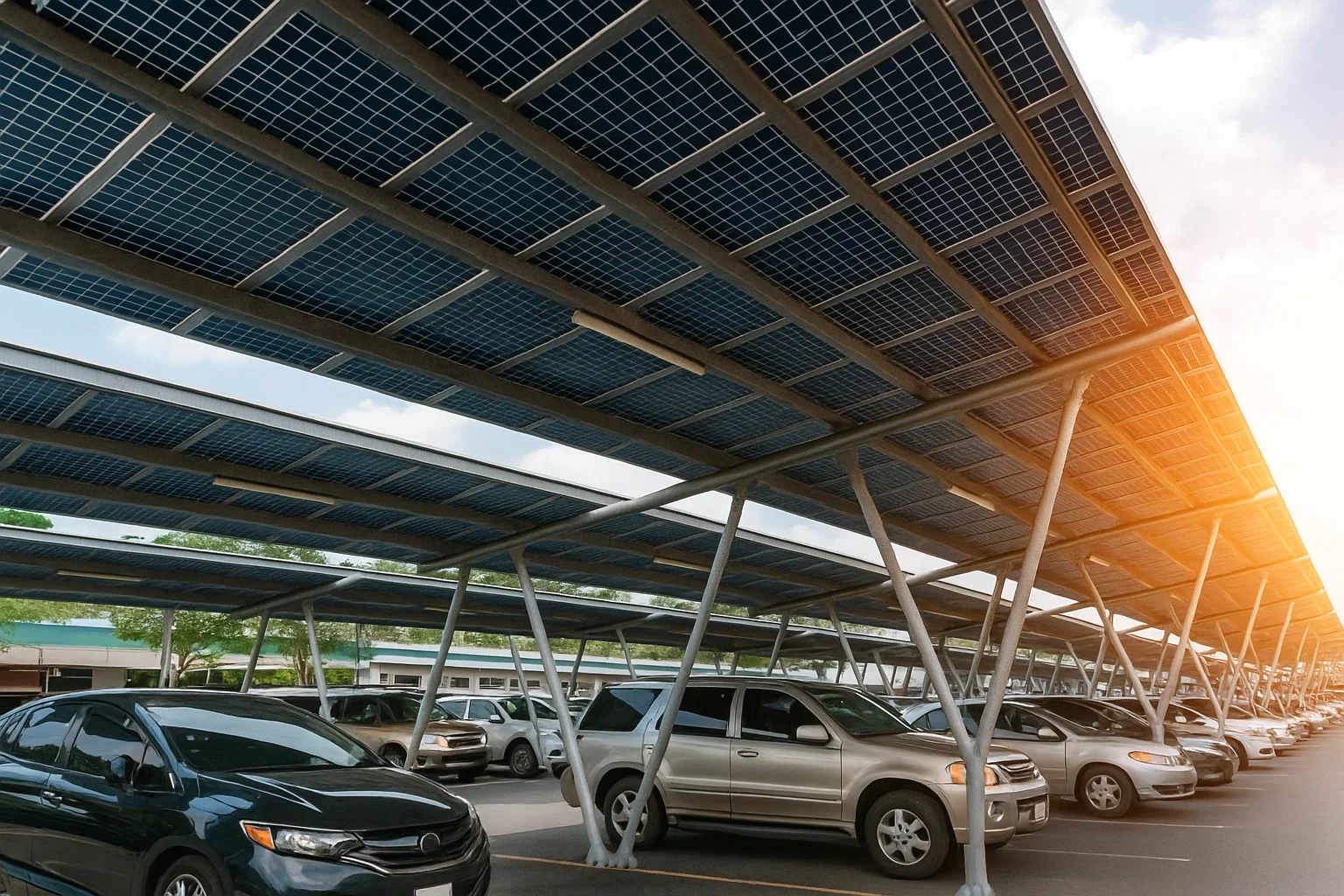
Table of Contents
Introduction: The Foundation of Commercial Success
For business owners and property managers, a well-designed and properly constructed parking lot is far more than just a place for vehicles—it's the first impression customers have of your establishment and a critical component of your property's functionality and value. A commercial parking lot that is thoughtfully planned, correctly installed, and properly maintained can significantly enhance customer experience, improve safety, and increase property value.
The process of installing a commercial parking lot involves much more than simply laying asphalt or concrete. It requires careful planning, knowledge of local regulations, proper drainage design, selection of appropriate materials, and skilled execution. Cutting corners during installation can lead to premature deterioration, safety hazards, and costly repairs down the line.
Industry Insight: According to the National Asphalt Pavement Association, properly installed and maintained asphalt parking lots can last 15-20 years or more, while poorly constructed lots may require major repairs in as little as 3-5 years. Investing in quality installation from the beginning can save businesses significant money over the life of the pavement.
In this comprehensive guide, we'll walk you through every aspect of commercial parking lot installation—from initial planning and design considerations to material selection, the installation process, cost analysis, and long-term maintenance. Whether you're building a new parking facility or renovating an existing one, this information will help you make informed decisions and ensure your investment provides maximum returns.
Phase 1: Planning and Design
The success of any commercial parking lot project begins long before the first shovel hits the ground. Proper planning and design are critical to creating a functional, durable, and cost-effective parking facility that meets your needs and complies with all regulations.
Site Assessment: Understanding Your terrain
Before any design work can begin, a thorough site assessment must be conducted to understand the existing conditions that will impact your parking lot installation.
Soil Testing: Analysis of soil composition, stability, and load-bearing capacity to determine appropriate base requirements.
Topographic Survey: Mapping of existing elevations to inform drainage planning and grading requirements.
Utility Location: Identification of existing underground utilities to avoid conflicts during excavation.
Environmental Considerations: Assessment of any environmental constraints or regulations that may impact design.
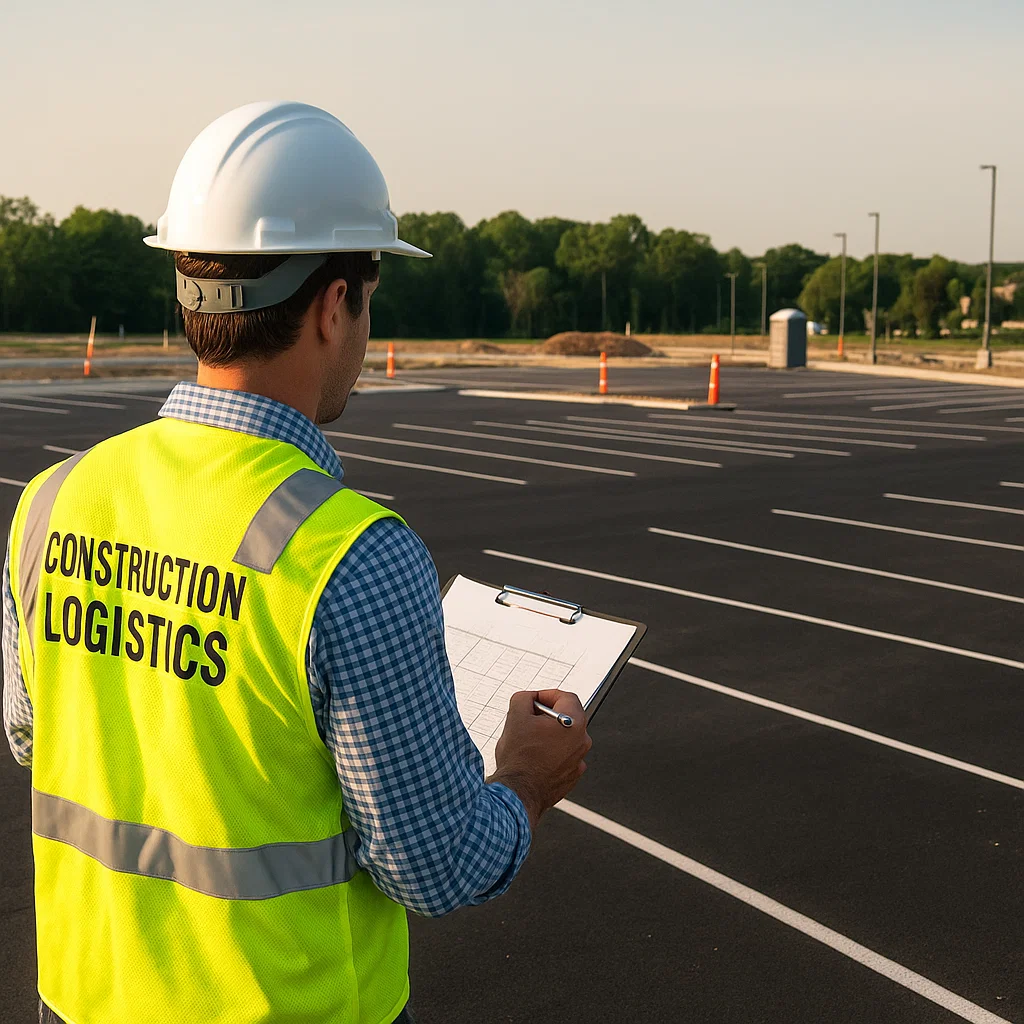
Design Considerations: Creating a Functional Layout
A well-designed parking lot balances multiple factors to create a safe, efficient, and user-friendly space.
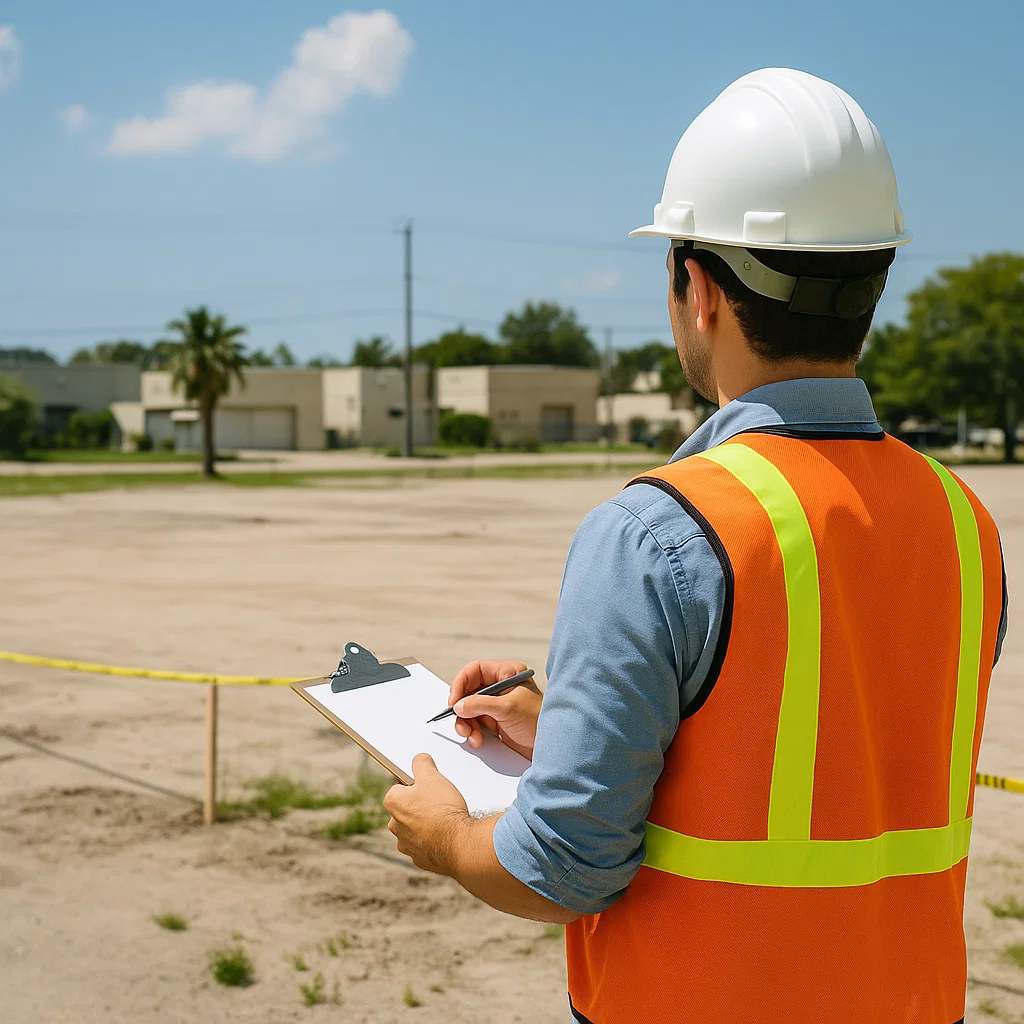
Parking Space Dimensions: Standard spaces are typically 9' x 18', but larger spaces may be needed for certain businesses or to meet ADA requirements.
Traffic Flow Patterns: Efficient entry and exit points, one-way aisles, and clear circulation paths reduce congestion.
Drainage Design: Proper slope (typically 1-2%) and strategic placement of drains prevent water accumulation and extend pavement life.
Lighting Planning: Adequate illumination enhances safety and security during evening hours.
Landscaping Integration: Strategic placement of green spaces and islands improves aesthetics and helps with drainage.
ADA Compliance Requirements
The Americans with Disabilities Act sets specific requirements for commercial parking lots:
Accessible Spaces
Minimum of 1 accessible space for every 25 spaces
Van Accessible
At least 1 van-accessible space for every 6 accessible spaces
Size Requirements
Standard accessible spaces: 8' wide with 5' access aisle
Signage
Proper signage at designated accessible parking spaces
Permitting and Regulations: Navigating Legal Requirements
Commercial parking lot projects typically require various permits and must comply with local, state, and federal regulations.
Zoning Approvals
Verification that parking lot design complies with local zoning ordinances regarding impervious surface limits, setbacks, and land use requirements.
Building Permits
Official authorization to begin construction, typically requiring submission of detailed plans and engineering calculations.
Stormwater Management
Compliance with EPA regulations and local stormwater management requirements, often requiring retention basins or other runoff controls.
Environmental Permits
Additional approvals may be needed if the project impacts wetlands, requires tree removal, or affects other protected resources.
Professional Tip: The permitting process can take several weeks or even months, depending on your location and the complexity of your project. Factor this timeline into your overall project schedule to avoid delays. Experienced contractors often have established relationships with local officials and can help navigate the permitting process more efficiently.
Materials: Choosing the Right Surface for Your Needs
Selecting the appropriate paving material is one of the most critical decisions in commercial parking lot installation. Each option has distinct advantages, limitations, and cost implications that must be considered in relation to your specific needs, budget, and climate.
| Material | Pros | Cons | Cost/SF (Installed) | Expected Lifespan |
|---|---|---|---|---|
| Asphalt | Cost-effective, quick installation, smooth surface, easy repairs | Regular maintenance needed, can soften in extreme heat | $3 - $5 | 15-20 years |
| Concrete | Durable, long-lasting, low maintenance, resistant to oil stains | Higher initial cost, longer installation time, can crack in freeze-thaw cycles | $6 - $10 | 20-30 years |
| Pavers | Aesthetic appeal, easy spot repairs, permeable options available | Higher cost, can shift over time, weed growth between joints | $10 - $20 | 20-25 years |
| Gravel | Lowest cost, quick installation, good drainage | High maintenance, not ADA compliant, dust issues | $1 - $3 | 5-10 years |
| Permeable Pavement | Environmental benefits, stormwater management, may qualify for incentives | Higher cost, specialized maintenance, limited load capacity | $8 - $15 | 15-20 years |
Asphalt vs. Concrete: A Detailed Comparison
The choice between asphalt and concrete is the most common dilemma for commercial property owners. Here's a more detailed comparison:
Asphalt Advantages
- •
Faster Installation: Can typically be used within 24-48 hours after installation
- •
Easier Repairs: Patches blend well and are less noticeable
- •
Winter Performance: Dark color helps melt snow and ice faster
- •
Cost-Effective: Generally 30-40% less expensive than concrete
Concrete Advantages
- •
Longer Lifespan: Can last 10+ years longer than asphalt with proper care
- •
Lower Maintenance: Requires less frequent repairs and resealing
- •
Heat Resistance: Doesn't soften in high temperatures like asphalt
- •
Design Options: Can be colored, stamped, or textured for aesthetic appeal
Climate Considerations
Your local climate should significantly influence your material choice:
Cold Climates
Asphalt performs well but requires regular sealing to protect against freeze-thaw damage. Concrete may be prone to salt deterioration.
Hot Climates
Concrete outperforms asphalt, which can soften and rut in extreme heat. Light-colored concrete also reduces heat island effect.
Wet Regions
Proper drainage is critical regardless of material. Permeable options can help manage stormwater runoff.
Coastal Areas
Concrete may be preferable due to its resistance to salt corrosion, though specialized asphalt mixes are also available.
Phase 2: The Installation Process
A properly executed installation process is critical to the longevity and performance of your commercial parking lot. While specific steps vary based on the chosen material, the following overview covers the typical process for an asphalt parking lot installation.
Step 1: Excavation and Grading
The first physical step in parking lot construction involves preparing the site for the new pavement. This process sets the foundation for everything that follows.
Clearing and Grubbing: Removal of vegetation, debris, and existing pavement (if applicable).
Excavation: Removal of soil to achieve proper depth for base materials. Depth varies based on expected traffic load.
Grading: Precise shaping of the subgrade to establish proper drainage patterns and contours.
Compaction: The subgrade is thoroughly compacted to achieve the required density and prevent future settling.
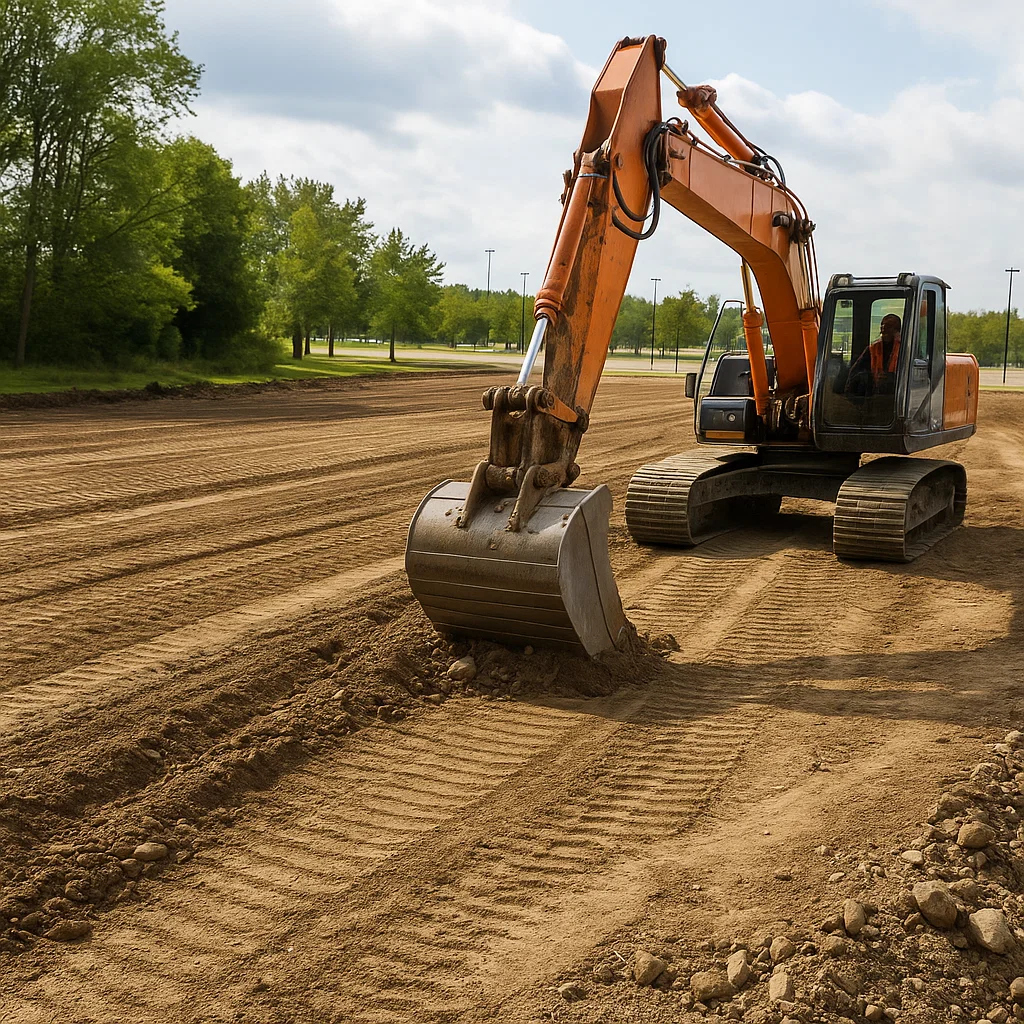
Grading Standards
Proper grading is essential for effective drainage:
Minimum Slope
1% (1/8" per foot)
Maximum Slope
5% (5/8" per foot)
Ideal Slope
2% (1/4" per foot)
Crown Height
1/4" per foot from center
Step 2: Base Installation
The base layer provides the structural foundation for your parking lot, distributing vehicle loads and preventing settlement. A properly installed base is critical to pavement longevity.
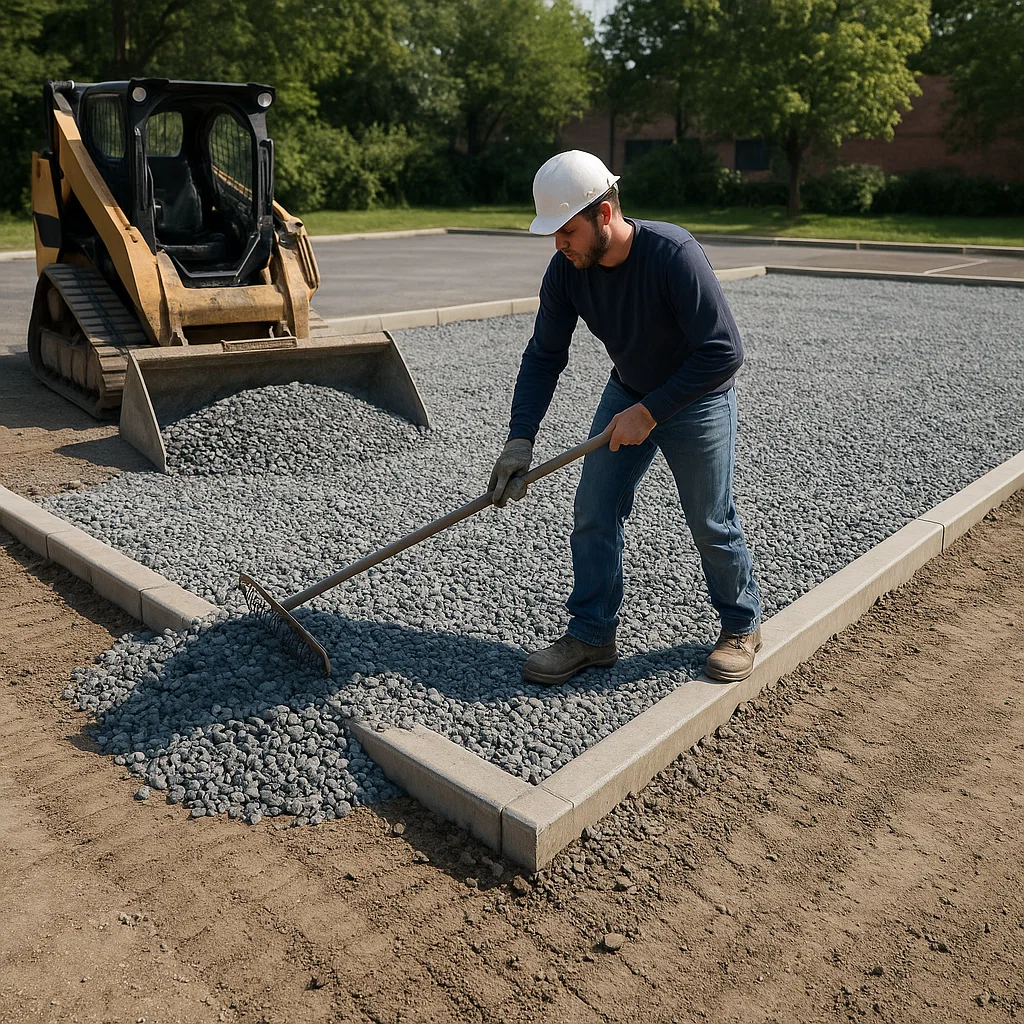
Material Selection: Typically crushed stone or recycled concrete aggregate, sized according to engineering specifications.
Layer Placement: Base material is spread in lifts (layers) of appropriate thickness, typically 4-6 inches per lift.
Moisture Control: Optimal moisture content is maintained to achieve proper compaction density.
Compaction: Each lift is thoroughly compacted with heavy rollers to achieve the required density (typically 95% of maximum density).
Quality Control: Density tests are performed to ensure the base meets engineering specifications before proceeding.
Base Thickness Recommendations
| Expected Traffic | Base Thickness | Total Thickness (Base + Surface) |
|---|---|---|
| Passenger Vehicles Only | 4-6 inches | 6-8 inches |
| Light Trucks/Vans | 6-8 inches | 8-10 inches |
| Mixed Use (Cars + Occasional Trucks) | 8-10 inches | 10-12 inches |
| Heavy Trucks/Constant Traffic | 10-12+ inches | 12-14+ inches |
Step 3: Paving and Compaction
The paving phase involves placing the surface material and achieving proper compaction. For asphalt parking lots, this process requires precise temperature control and timing.
Material Delivery
Hot mix asphalt is delivered at temperatures between 275-325°F. Timing is critical to ensure proper workability and compaction.
Paving Operation
An asphalt paver spreads the material evenly at the predetermined depth, typically 2-3 inches for commercial parking lots.
Initial Compaction
A steel-wheel roller follows immediately behind the paver to achieve initial compaction before the asphalt cools too much.
Final Compaction
A pneumatic roller completes the compaction process, achieving the target density (typically 92-95% of theoretical maximum density).
Quality Check: Proper compaction is critical to pavement performance. Inadequate compaction can lead to premature raveling, cracking, and reduced lifespan. Core samples may be taken to verify density meets specifications.
Step 4: Finishing and Striping
The final steps involve applying surface treatments, installing necessary features, and marking the parking spaces and traffic patterns.
Curing Time
- •
Asphalt: Typically requires 24-48 hours before light traffic can be allowed, 3-7 days for full curing
- •
Concrete: Requires 7 days before light traffic, 28 days for full strength development
- •
Temperature Sensitivity: Curing times vary significantly with temperature and humidity
Striping and Signage
- •
Layout Marking: Precise measurement and marking of parking spaces, aisles, and traffic flow patterns
- •
Striping Application: High-quality traffic paint or thermoplastic applied according to ADA and local regulations
- •
Signage Installation: Placement of regulatory signs, directional signs, and accessible parking designations
Additional Features
- •
Wheel Stops: Installation where needed to prevent vehicles from overhanging sidewalks or landscaping
- •
Lighting: Installation of pole lights and electrical connections for parking lot illumination
- •
Landscaping: Placement of islands, planting areas, and protective bollards as designed
Final Inspection
- •
Quality Assessment: Thorough inspection of the completed work for compliance with specifications
- •
Documentation: Provision of warranty information, maintenance guidelines, and as-built drawings
- •
Client Walkthrough: Review of the completed project with the property owner or manager
Cost Analysis: Budgeting for Your Parking Lot
Understanding the costs associated with commercial parking lot installation helps you budget appropriately and make informed decisions about materials and features. Prices vary based on location, materials, size, site conditions, and current market factors.
Average Installation Costs by Material
| Material | Cost per SF | 10,000 SF Lot | 50,000 SF Lot | Notes |
|---|---|---|---|---|
| Asphalt | $3 - $5 | $30,000 - $50,000 | $150,000 - $250,000 | Most common choice for commercial lots |
| Concrete | $6 - $10 | $60,000 - $100,000 | $300,000 - $500,000 | Higher initial cost but longer lifespan |
| Pavers | $10 - $20 | $100,000 - $200,000 | $500,000 - $1,000,000 | Premium option for high-end properties |
| Gravel | $1 - $3 | $10,000 - $30,000 | $50,000 - $150,000 | Temporary or low-budget solution only |
Additional Cost Factors
Several variables can significantly impact the final cost of your parking lot project:
Site Preparation Costs
- •
Clearing and Grubbing: $1,000 - $5,000+ depending on vegetation
- •
Demolition: $2 - $7 per SF for removing existing pavement
- •
Grading: $1,000 - $10,000+ depending on site complexity
- •
Soil Stabilization: Additional $1 - $3 per SF for problematic soils
Additional Features
- •
Drainage Systems: $5,000 - $50,000+ depending on complexity
- •
Lighting: $2,000 - $10,000 per pole installed
- •
Landscaping: $1 - $5 per SF for islands and plantings
- •
Striping and Signage: $1,000 - $5,000 for typical commercial lot
Long-Term Cost Considerations
Asphalt Maintenance
$0.10 - $0.30 per SF annually for sealing and repairs
Concrete Maintenance
$0.05 - $0.15 per SF annually for cleaning and joint sealing
Resurfacing Costs
$1.50 - $3.00 per SF every 10-15 years for asphalt overlay
Budgeting Tip: Always include a contingency of 10-15% in your budget for unexpected site conditions or changes during construction. Obtain multiple bids from reputable contractors and ensure they include all aspects of the project in their quotes for accurate comparison. For businesses considering asphalt parking lot installation, make sure the proposal clearly covers materials, drainage, and long-term maintenance.
Maintenance and Longevity
Proper maintenance is essential to maximize the lifespan of your commercial parking lot and protect your investment. A well-maintained parking lot not only lasts longer but also creates a better impression for customers and reduces liability risks.
Recommended Maintenance Schedule
| Timeframe | Asphalt Tasks | Concrete Tasks |
|---|---|---|
| Monthly | Inspect for cracks, drainage issues, and surface damage | Inspect for cracks, spalling, and joint conditions |
| Annually | Clean surface, repair cracks, inspect markings | Clean surface, inspect and clean drainage systems |
| 2-3 Years | Seal coating (after first year, then every 2-3 years) | Deep cleaning, joint sealing if needed |
| 5-7 Years | Evaluate for overlay needs, restriping | Evaluate for surface treatments, restriping |
| 10-15 Years | Consider overlay or partial reconstruction | Evaluate for major repairs or replacement |
Common Maintenance Tasks
Regular maintenance addresses minor issues before they become major problems:
Crack Sealing: Filling cracks to prevent water infiltration, which can undermine the base course. Should be done when cracks reach 1/4" width.
Seal Coating (Asphalt): Protective coating that extends asphalt life by preventing oxidation, resisting oil and chemical spills, and restoring appearance. Typically applied every 2-3 years.
Patching: Repairing isolated areas of deterioration before they expand. Methods include throw-and-roll, semi-permanent, and full-depth patches.
Restriping: Maintaining clear, visible markings for parking spaces, traffic flow, and safety zones. Typically needed every 1-2 years depending on traffic volume.
Drainage Maintenance: Keeping drains, catch basins, and drainage channels clear of debris to prevent water accumulation that can damage pavement.
Extending Pavement Life
Proactive maintenance can significantly extend the life of your parking lot:
Asphalt Lifespan
With proper maintenance: 15-20 years
Without maintenance: 8-12 years
Concrete Lifespan
With proper maintenance: 20-30 years
Without maintenance: 15-20 years
Cost Savings
$1 in regular maintenance can prevent $3-$5 in future repairs
Resurfacing vs Replacement
Resurfacing costs 30-50% of full replacement when done at the right time
Benefits of Professional Installation
Investing in professional commercial parking lot installation delivers significant benefits that extend far beyond simply providing a place to park vehicles. A well-designed and properly constructed parking lot contributes to your business success in multiple ways.
Enhanced Customer Experience
- •
Creates positive first impression of your business
- •
Provides safe, convenient parking for customers
- •
Reduces congestion and frustration during peak hours
- •
Accessible design accommodates all customers
Increased Property Value
- •
Well-maintained parking lots significantly enhance property appeal
- •
Professional installation adds to overall property valuation
- •
Attracts higher-quality tenants for commercial properties
- •
Reduces liability risks through proper safety features
Operational Efficiency
- •
Optimized traffic flow reduces congestion and delays
- •
Adequate parking space reduces customer turnover
- •
Proper loading zones facilitate efficient deliveries
- •
Clear signage improves wayfinding and reduces confusion
Environmental Benefits
- •
Proper drainage reduces stormwater runoff and pollution
- •
Permeable options recharge groundwater supplies
- •
Light-colored surfaces reduce heat island effect
- •
Landscaped islands provide green space and habitat
Case Study: Retail Center Transformation
A struggling shopping center with a deteriorating parking lot invested $350,000 in a complete parking lot redesign and reconstruction. Results within 12 months:
22%
Increase in Customer Traffic
15%
Increase in Tenant Retention
$1.2M
Property Value Increase
0
Slip/Fall Incidents
Return on Investment Analysis
While the initial investment in a quality parking lot can be substantial, the returns justify the expense:
- •
Increased Business: Studies show better parking can increase retail sales by 5-10%
- •
Reduced Maintenance: Proper installation reduces long-term repair costs by 30-50%
- •
Liability Reduction: Well-maintained lots reduce slip/fall claims and associated costs
- •
Property Value: Quality parking facilities can increase commercial property values by 10-20%
Conclusion: Your Investment in Quality
A commercial parking lot is far more than just paved space for vehicles—it's a critical business asset that influences customer perceptions, operational efficiency, safety, and property value. The decision to invest in professional parking lot installation is one that pays dividends for years to come.
From careful planning and design through proper construction and ongoing maintenance, each phase of the parking lot lifecycle contributes to its overall performance and longevity. While cost is always a consideration, the focus should be on value rather than just initial price. A well-executed project using quality materials and following best practices will deliver superior returns compared to cut-rate alternatives that may require frequent repairs and premature replacement.
Ready to Transform Your Property?
Our parking lot construction experts are ready to guide you through every step of your project, from initial concept to final completion.
Remember that your parking lot is often the first physical interaction customers have with your business. Making that experience positive through a well-designed, properly constructed, and well-maintained parking facility sends a powerful message about your attention to quality and customer care. By partnering with experienced professionals and following the guidelines outlined in this guide, you can ensure your parking lot investment delivers maximum returns for years to come.
